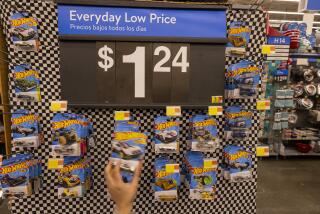Tiny ‘Smart Cards’ Our Wallets of the Future? : Consumers: Businesses are touting multiple-use computerized cards that could replace cash.
- Share via
NEW YORK — If you’re like most consumers, your wallet bulges with cards. You have credit cards, ATM cards, health insurance ID, drivers license and more. For relief, the nation’s businesses propose you replace all this with just one card-shaped device that serves as loose change as well.
The so-called smart card has already appeared in subways and at public telephones as the “electronic purse.” This allows customers to pay for rides and calls with a prepaid card that “remembers” each transaction.
About 2,000 universities issue them to pay for photocopies, laundry machines and parking meters. Some cards even have calculators.
Ultimately, your doctor will be able to stick your card--embedded with a microchip--into a personal computer for your medical history. In the same way, your smart card “checkbook” can be balanced to keep tabs on your spending at the end of the day.
Unlike the magnetic stripe on today’s plastic cards, the microchip is hard to tamper with, guaranteeing more safety for you and your bank. Some chips may also respond to your voice, eliminating concerns about a lost, stolen or forgotten password or identification number.
The Smart Card Forum--a group of about 130 businesses and government agencies--is drawing up specifications to promote multiple application cards for use everywhere from toll gates to hospitals.
“What will drive this is the consumer’s desire to reduce pieces of plastic,” Ronald Braco, director of electronic services at Chemical Bank, said at a press briefing.
The technology has been around for 10 years and is commonly used in France, Germany, Japan and Singapore to pay for public phone calls. The idea has taken longer to catch on here, since a good and fairly inexpensive telecommunications system has favored the use of credit and debit cards.
“The (smart card) technology is now cheaper, the capability has increased, there’s more demand for convenience and trial results have been good internationally,” said Braco, who is on the board of the year-old forum. “Cash is heavy, dirty and labor intensive.”
Cash transactions, which account for 73.4% of all purchases in the country, will probably present the biggest opportunity for smart cards, he said.
Mastercard International, which began putting chips into its cards in July, estimates Americans make more than 237 billion cash purchases totaling $600 billion each year. It said that 84% of the purchases are for less than $20.
As a result, the New York-based company plans to unroll in 1996 its first credit and debit cards with a prepaid feature that will replace coins and small bills.
Details have not been set, but cardholders may transfer up to $50, for example, into an “electronic purse” in their smart card at ATMs or at a store or restaurant.
The cards will reduce paperwork for banks and card issuers and also cut down on fraud--which cost them $1 trillion worldwide last year--since an embedded microchip is harder to tamper with than magnetic strip technology.
Until smart cards become common currency, they will have both a chip and a magnetic strip, Smart Card Forum officials said.
Banks can also customize services on smart cards, offering a menu of services similar to those that come up on ATM screens. As with credit cards, banks may link up with health care providers, phone companies, retailers and airlines to offer frequent shopping and flyer programs and other services.
Banks aren’t worried that prepaid cards will take away income from credit and debit card businesses. In fact, customers transferring money from bank accounts to smart cards will save banks from paying interest on the funds.
More to Read
Inside the business of entertainment
The Wide Shot brings you news, analysis and insights on everything from streaming wars to production — and what it all means for the future.
You may occasionally receive promotional content from the Los Angeles Times.










